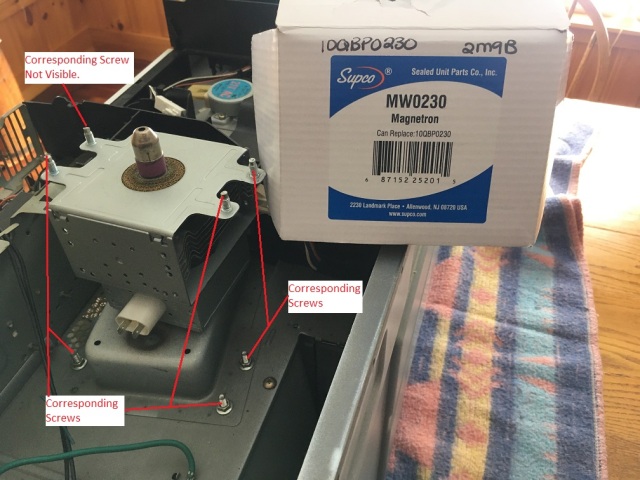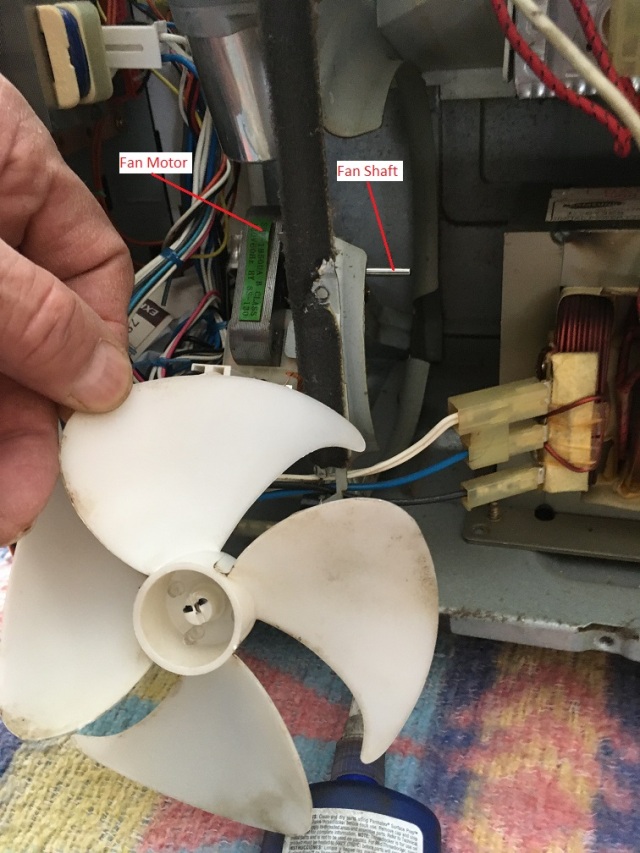In Memoriam: JRC, Unity, Maine, December 27, 1949 – October 30, 2014.
This post describes my efforts to eliminate (or at least reduce) loud noises in our GE microwave, Model Number JVM1850BH02, which was manufactured in 2004, and has had a lot of use.
If you read this entire post, please consider the note, dated January 3, 2022, at the end.
Here’s a photo of the microwave: To get it off the wall, you must open the cabinet doors above it and remove three long screws. A right angle drill makes that a snap. Tilt the microwave downward about 45 degrees and then lift the back side up off the mounting bracket. That’s easier said than done; you’ll probably need a helper.
To get it off the wall, you must open the cabinet doors above it and remove three long screws. A right angle drill makes that a snap. Tilt the microwave downward about 45 degrees and then lift the back side up off the mounting bracket. That’s easier said than done; you’ll probably need a helper.
This particular microwave has been making a lot of on-again-off-again noises for a few years. Several attempts to diagnose and repair the noises have been made, without success (until now). All the moving parts (fans and motors) have been rotating freely, with no sign of imbalance or worn or damaged bearings. I could find nothing wrong.
Early this month (December, 2021) I tried again. An internet search indicated that the magnetron might be causing the problem. So, I purchased a new one from ApplianceFactoryParts.com. This is their part number 10QBP0230; the box is shown in the next photo: The new magnetron is installed in the microwave, and is not visible in the photo. The original magnetron is sitting atop the new one. The original magnetron was held in place by the four 5mm studs shown. The studs are pressed into the sheet metal so that they will not fall out as the magnetron is lifted into place and fastened with the nuts.
The new magnetron is installed in the microwave, and is not visible in the photo. The original magnetron is sitting atop the new one. The original magnetron was held in place by the four 5mm studs shown. The studs are pressed into the sheet metal so that they will not fall out as the magnetron is lifted into place and fastened with the nuts.
The replacement magnetron, however, came with four 4mm screws and nuts, which promptly fall out as soon as you try to lift the magnetron into place. And, there is no access whatsoever to the underside of those screws. I rate the difficulty of installation with the provided screws as “impossible.” So, I got some larger (5mm) screws and tapped the holes in the magnetron, then inserted the screws, lifted the magnetron into place, and installed it, using the original 5mm nuts. The replacement magnetron seems to work just fine, but the installation hardware provided is totally unacceptable.
I suppose I shouldn’t complain too much; the new replacement magnetron cost me $54.06 ($64.05 with the shipping), whereas the OEM magnetron (GE Part Number WB27X10017) currently costs $249.22 plus shipping.
At any rate, the new magnetron did not fix the problem; the noises continued, unabated. Then, on Christmas day, my son tried to use the microwave, and the noise suddenly got a lot louder and much higher pitch, a major departure from all previous noises.
My son suspected that the turntable, which wasn’t turning, was the source of the noise. I didn’t think so because we had been having a loud noise for a long time, with or without the turntable in operation, and besides, it’s probably impossible to get such a high-pitched noise from a motor that turns at only 3 rpm.
Whatever the cause, we now had a very loud screeching noise coming from the microwave, but the noise was intermittent; it came at random, but, once it started, it didn’t go away until the microwave was stopped. Upon restarting, the noise would usually be gone, for a short while, before it started again.
The next photo shows what I found after removing the microwave from the wall and peering inside: The cooling fan for the transformer had fallen off its shaft. I shoved it back on, but it was very loose. So, I tried some Red Loctite:
The cooling fan for the transformer had fallen off its shaft. I shoved it back on, but it was very loose. So, I tried some Red Loctite: It didn’t work; the Loctite just wouldn’t cure; even after several hours, the Loctite was still liquid. I next tried some Super Glue; but that also would not cure; even after 24 hours, it had not hardened. Quite surprising, but that’s the way it was.
It didn’t work; the Loctite just wouldn’t cure; even after several hours, the Loctite was still liquid. I next tried some Super Glue; but that also would not cure; even after 24 hours, it had not hardened. Quite surprising, but that’s the way it was.
The next photo shows what I did to fix the fan blade: I made a collar out of 3/4″ aluminum rod, then drilled and tapped it for two #6-32 set screws. Then I drilled two holes through the hub of the fan so I could access the set screws with my Allen wrench.
I made a collar out of 3/4″ aluminum rod, then drilled and tapped it for two #6-32 set screws. Then I drilled two holes through the hub of the fan so I could access the set screws with my Allen wrench.
Here’s another view of the same thing: And here’s a view of the fan blade, back in place, with my Allen wrench in use:
And here’s a view of the fan blade, back in place, with my Allen wrench in use: The set screws are tightened against the plastic hub and squeeze the plastic against the steel shaft. The noises are now all gone, and I think they won’t be coming back anytime soon. I consider the fan blade to now be “better than new.” It should never come loose again.
The set screws are tightened against the plastic hub and squeeze the plastic against the steel shaft. The noises are now all gone, and I think they won’t be coming back anytime soon. I consider the fan blade to now be “better than new.” It should never come loose again.
xxxxxxxxxxxxxxxxxxxxxxxxxxxxxxxxxxxxxxxxxxxxxxxxxxxxxxxxxxxxxxxxxxxxxxxxxxxxxxx
Note added June 19, 2022 (between the rows of x’s):
So much for “It should never come loose again.” It did come loose again. The two setscrews were pressing against the inner plastic hub, clamping it to the steel shaft of the motor. Roughly 6 months after the initial repair, the fan blade came loose and the fan again made just as much noise as it had previously. So I removed the two setscrews and replaced them with two 6-32 x 1″ long screws (actually salvaged from a failed electrical switch). I drilled two holes through the inner plastic hub, which allowed the two screws to make contact directly with the fan’s axial shaft. You can see one of the two screws in this photo:
 Now I think I can safely say that: “It should never come loose again.”
Now I think I can safely say that: “It should never come loose again.”
xxxxxxxxxxxxxxxxxxxxxxxxxxxxxxxxxxxxxxxxxxxxxxxxxxxxxxxxxxxxxxxxxxxxxxxxxxxxxxx
As for the cause of the noises:
1. I’d guess that before the fan blade came completely off, there was some wobble in the blade that caused noise; the exact mechanism is not clear to me.
2. But, I’m fairly confident that I do know the cause of the loud screech after the fan blade fell off. My theory is that, because the armature of the motor is fairly long relative to its diameter, the polar moment of inertia is smaller than the moment perpendicular to the axis. That makes the motor unstable without the fan blade attached, so it wants to “flip” and rotate about a different axis. That sets up a vibration, that, once it starts, will not go away.
Note added January 2, 2022:
After pondering this for the past week, I now think I know what was causing the noises before the fan blade fell off. I believe that, because the fan blade was so loose, it was spinning very slowly, not fast enough to stabilize the motor armature, so the armature still wanted to flip and rotate about a perpendicular axis. But the mass of the fan blade was sufficient to dampen the vibration and keep the frequency of the vibration much lower than it became once the fan blade fell completely off.
That’s my theory, and I’m sticking to it.
——————————————————————————————————–
Note added January 3, 2022:
Perhaps this is a one-of-a-kind failure, but I suspect that this failure mode is likely to be fairly common, with a lot of microwaves making unexplained loud noises. Yet, my own Internet searches have turned up no references to such a failure mode. If this is, as I suspect, fairly common, then it would be good if people could find this post via a Google search, since nobody else seems to have identified the problem.
If you are able, could you please post a link to this article so it might begin to “trickle up” in the Google ratings and people might find it.
Thanks.
Tom